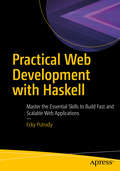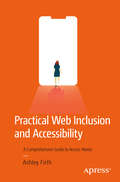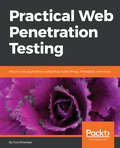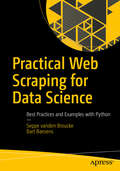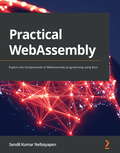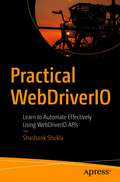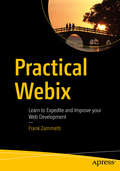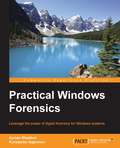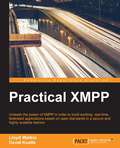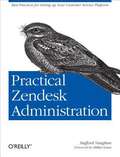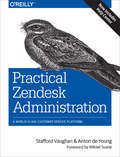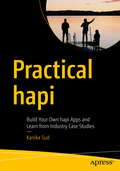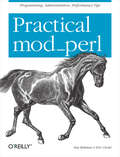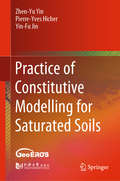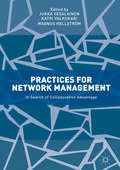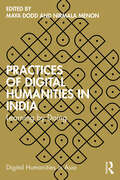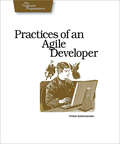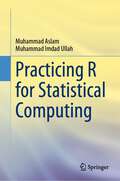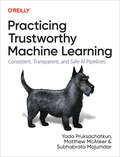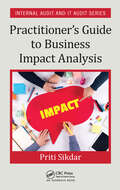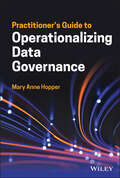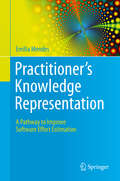- Table View
- List View
Practical Web Development with Haskell: Master the Essential Skills to Build Fast and Scalable Web Applications
by Ecky PutradyLearn how to advance your skill level of Haskell, and use this language for practical web development. This book uses a direct, no nonsense approach, so you no longer need to spend extra time reading the documentation, blog posts, and forums to understand how to use Haskell – all that knowledge is provided in one coherent resource. You'll start by reviewing how multiple facets of web development are done in Haskell, such as routing, building HTMLs, interacting with databases, caches, and queues, etc. You'll then move on to using notable libraries, such as "scotty" for routings, "digestive-functor" for input validation, and "postgresql-simple" for interacting with databases. In the later chapters, you'll learn how all of these libraries can be used together by working on a fully functioning project deployed on Heroku. What You'll Learn Set up a productive Haskell development environmentReview basic tasks that are encountered when building web applications.Explore how to interact with external systems, such as databases, queues, and RESTful APIs. Build a RESTful API, website, building views and form validation.Who This Book Is ForSoftware developers familiar Haskell and would like to apply the knowledge on real world applications and software developers new to Haskell.
Practical Web Inclusion and Accessibility: A Comprehensive Guide to Access Needs
by Ashley FirthThe web has to be inclusive. One in five people living in the UK have a disability. From Microsoft’s “inclusive design” movement - creating adaptive controllers for users with a range of disabilities - to Beyoncé’s site being sued for failure to be accessible, the importance of considering access needs is gaining mainstream attention. Recognizing and catering for a range of disabilities in our online platforms is key to achieving a truly inclusive web.You’ll be guided through a broad range of access needs, the barriers users often face, and provided practical advice on how your sites can help rather than hinder. Going beyond advice tailored solely for developers, this book offers potential improvements for designers, developers, user experience professionals, QA and testers, so that everyone involved in building a website can engage with the concepts without the need to understand how to code.Learn about the very latest technology - such as natural language processing and smart home tech - and explore its application accessibly. This book comes complete with practical examples you can use in your own sites and, for the first time in any web accessibility book, access needs experienced by those with mental health disorders and cognitive impairments are comprehensively covered. Applicable to both new projects and those maintaining existing sites and looking for achievable improvements on them, Practical Web Inclusion and Accessibility gives you all the information you need to ensure that your sites are truly accessible for the modern, inclusive web.What You Will LearnUnderstand the vast range of disabilities that have online access needsApply the practical steps required to cater for those needsUse new technology to open up exciting avenues for the sites you create and maintainApproach accessibility from a full spectrum of online disciplinesStart thinking about users with specific disabilities and how it impacts your workWho This Book Is ForAnyone who wants to have a greater understanding of the inclusive web and considerations that should be made. You do not need to have coding knowledge.
Practical Web Penetration Testing: Secure web applications using Burp Suite, Nmap, Metasploit, and more
by Gus KhawajaLearn how to execute web application penetration testing end-to-endKey FeaturesBuild an end-to-end threat model landscape for web application securityLearn both web application vulnerabilities and web intrusion testingAssociate network vulnerabilities with a web application infrastructureBook DescriptionCompanies all over the world want to hire professionals dedicated to application security. Practical Web Penetration Testing focuses on this very trend, teaching you how to conduct application security testing using real-life scenarios.To start with, you’ll set up an environment to perform web application penetration testing. You will then explore different penetration testing concepts such as threat modeling, intrusion test, infrastructure security threat, and more, in combination with advanced concepts such as Python scripting for automation. Once you are done learning the basics, you will discover end-to-end implementation of tools such as Metasploit, Burp Suite, and Kali Linux. Many companies deliver projects into production by using either Agile or Waterfall methodology. This book shows you how to assist any company with their SDLC approach and helps you on your journey to becoming an application security specialist.By the end of this book, you will have hands-on knowledge of using different tools for penetration testing.What you will learnLearn how to use Burp Suite effectivelyUse Nmap, Metasploit, and more tools for network infrastructure testsPractice using all web application hacking tools for intrusion tests using Kali LinuxLearn how to analyze a web application using application threat modelingKnow how to conduct web intrusion testsUnderstand how to execute network infrastructure testsMaster automation of penetration testing functions for maximum efficiency using PythonWho this book is forPractical Web Penetration Testing is for you if you are a security professional, penetration tester, or stakeholder who wants to execute penetration testing using the latest and most popular tools. Basic knowledge of ethical hacking would be an added advantage.
Practical Web Scraping for Data Science: Best Practices And Examples With Python
by Bart Baesens Seppe Vanden BrouckeThis book provides a complete and modern guide to web scraping, using Python as the programming language, without glossing over important details or best practices. Written with a data science audience in mind, the book explores both scraping and the larger context of web technologies in which it operates, to ensure full understanding. The authors recommend web scraping as a powerful tool for any data scientist’s arsenal, as many data science projects start by obtaining an appropriate data set.Starting with a brief overview on scraping and real-life use cases, the authors explore the core concepts of HTTP, HTML, and CSS to provide a solid foundation. Along with a quick Python primer, they cover Selenium for JavaScript-heavy sites, and web crawling in detail. The book finishes with a recap of best practices and a collection of examples that bring together everything you've learned and illustrate various data science use cases. What You'll LearnLeverage well-established best practices and commonly-used Python packages Handle today's web, including JavaScript, cookies, and common web scraping mitigation techniques Understand the managerial and legal concerns regarding web scrapingWho This Book is ForA data science oriented audience that is probably already familiar with Python or another programming language or analytical toolkit (R, SAS, SPSS, etc). Students or instructors in university courses may also benefit. Readers unfamiliar with Python will appreciate a quick Python primer in chapter 1 to catch up with the basics and provide pointers to other guides as well.
Practical WebAssembly: Explore the fundamentals of WebAssembly programming using Rust
by Sendil Kumar NellaiyapenUnderstand the basic building blocks of WebAssembly and learn, install, and use various tools from the Rust and WebAssembly ecosystemKey FeaturesUnderstand the Rust programming language and WebAssembly concepts for web developmentBuild web, mobile, and embedded apps using WebAssemblyEnhance the scalability and resilience of your web appsBook DescriptionRust is an open source language tuned toward safety, concurrency, and performance. WebAssembly brings all the capabilities of the native world into the JavaScript world. Together, Rust and WebAssembly provide a way to create robust and performant web applications. They help make your web applications blazingly fast and have small binaries. Developers working with JavaScript will be able to put their knowledge to work with this practical guide to developing faster and maintainable code. Complete with step-by-step explanations of essential concepts, examples, and self-assessment questions, you'll begin by exploring WebAssembly, using the various tools provided by the ecosystem, and understanding how to use WebAssembly and JavaScript together to build a high-performing application. You'll then learn binary code to work with a variety of tools that help you to convert native code into WebAssembly. The book will introduce you to the world of Rust and the ecosystem that makes it easy to build/ship WebAssembly-based applications. By the end of this WebAssembly Rust book, you'll be able to create and ship your own WebAssembly applications using Rust and JavaScript, understand how to debug, and use the right tools to optimize and deliver high-performing applications.What you will learnExplore WebAssembly and the different tools available in the WebAssembly ecosystemUnderstand the raw WebAssembly binary and the WebAssembly text formatUse the Web and JavaScript API with wasm-bindgenOptimize Rust and WebAssembly for high performanceRun and debug WebAssembly and Rust codeExplore various tools available in the RustWASM ecosystemWho this book is forThis book is for JavaScript developers who want to deliver better performance and ship type-safe code. Rust developers or backend engineers looking to build full-stack applications without worrying too much about JavaScript programming will also find the book useful.
Practical WebDriverIO: Learn to Automate Effectively Using WebDriverIO APIs
by Shashank ShuklaLearn how to quickly set up the test automation tool WebdriverIO, one of the major Node.js-based test frameworks. Software testing is here to stay, and an integral part of this is test automation. Dive into the amazing possibilities that WebDriverIO offers to automate browser interactions for a user of any web application. You will learn to automate a vast range of actions that a user takes to interact with the browser. From a simple click to more complex user actions such as frame switches, selecting from drop-downs, and file downloads using WebDriverIO APIs. You will also learn about assertions, timeouts, waits, parallel testing frameworks, and the general pros and cons of WebDriverIO.With over 150 working code samples demonstrating various test scenarios that you require in your day-to-day automation testing, this book is your practical handbook to WebDriverIO. What You'll Learn Set up and install WebdriverIO efficientlyRun parallel execution using WebdriverIOReview the pros, cons and challenges you may face with WebdriverIOEnsure optimum usage and avoid common mistakes Who This Book Is ForThis book is ideal for test engineers who have a basic understanding of test automation with Selenium, developers who want to implement this testing tool for internal testing, Test Managers/IT Project Managers who want to get some general understanding of this tool and its advantage, and students who want to pursue career in test automation.
Practical Webix: Learn To Speed Up Your Web Development
by Frank ZammettiLearn to create speedy cross-platform applications with ease using Webix. You will begin with an introduction to Webix and basic usage, exploring the interface components and utilities it offers, as well as the tools available (skin builder, form builder, and code snippet testing facility).You’ll understand how Webix can integrate with other popular libraries and frameworks including Angular, Vue, React and more (as well as third-party components like dHTMLx and rich text editors). You will learn tangential topics including communication with back-end systems (Node.js and common related tooling), packaging as a Cordova app and, of course, you will learn how to use Webix following the Progressive Web App delivery mechanism.Offering a complete solution in a single bundle, this JavaScript UI framework provides a rich set of interface components, application architecture direction and commonly-needed utility and ancillary capabilities.Every topic will be taught a practical way, explored within the context of building real-world working apps, not through unrelated snippets. Bringing 25 years of professional development experience to the table, author Frank Zammetti uses his unique levity to teach you how to get up and running with this new and upcoming framework. What You’ll Learn Explore the capabilities and UI widgets it provides and the features that make it stand out from its competitorsBuild one web technology-based app that works on both desktops and mobile devices (Android and iOS)Create and hook a Webix app up to a Node.js/Express-based RESTful server API for data storageMobilize a Webix app using both PhoneGap and Progressive Web App techniquesEnhance your Webix and general development skills in the most fun way possible: by building a gameWho This Book Is For Moderately experienced front-end developers who want to learn about Webix and the power it brings to client-side development. Developers looking to use their web development skills to build cross-platform apps that work on both desktop and mobile devices with Webix as the foundation.A working knowledge of CSS, HTML and JavsScript is assumed, though you don’t need to be an expert.
Practical Windows Forensics
by Ayman Shaaban Konstantin SapronovLeverage the power of digital forensics for Windows systems About This Book * Build your own lab environment to analyze forensic data and practice techniques. * This book offers meticulous coverage with an example-driven approach and helps you build the key skills of performing forensics on Windows-based systems using digital artifacts. * It uses specific open source and Linux-based tools so you can become proficient at analyzing forensic data and upgrade your existing knowledge. Who This Book Is For This book targets forensic analysts and professionals who would like to develop skills in digital forensic analysis for the Windows platform. You will acquire proficiency, knowledge, and core skills to undertake forensic analysis of digital data. Prior experience of information security and forensic analysis would be helpful. You will gain knowledge and an understanding of performing forensic analysis with tools especially built for the Windows platform. What You Will Learn * Perform live analysis on victim or suspect Windows systems locally or remotely * Understand the different natures and acquisition techniques of volatile and non-volatile data. * Create a timeline of all the system actions to restore the history of an incident. * Recover and analyze data from FAT and NTFS file systems. * Make use of various tools to perform registry analysis. * Track a system user's browser and e-mail activities to prove or refute some hypotheses. * Get to know how to dump and analyze computer memory. In Detail Over the last few years, the wave of the cybercrime has risen rapidly. We have witnessed many major attacks on the governmental, military, financial, and media sectors. Tracking all these attacks and crimes requires a deep understanding of operating system operations, how to extract evident data from digital evidence, and the best usage of the digital forensic tools and techniques. Regardless of your level of experience in the field of information security in general, this book will fully introduce you to digital forensics. It will provide you with the knowledge needed to assemble different types of evidence effectively, and walk you through the various stages of the analysis process. We start by discussing the principles of the digital forensics process and move on to show you the approaches that are used to conduct analysis. We will then study various tools to perform live analysis, and go through different techniques to analyze volatile and non-volatile data. Style and approach This is a step-by-step guide that delivers knowledge about different Windows artifacts. Each topic is explained sequentially, including artifact analysis using different tools and techniques. These techniques make use of the evidence extracted from infected machines, and are accompanied by real-life examples.
Practical XMPP
by Lloyd Watkin David KoelleUnleash the power of XMPP in order to build exciting, real-time, federated applications based on open standards in a secure and highly scalable fashion About This Book * Learn about the fundamentals of XMPP and be able to work with the core functionality both server-side and in the browser * Build a simple 1-to-1 chat (the "Hello World" of XMPP), explore multi-user chat, publish subscribe systems, and work with a decentralized social network * Author Lloyd Watkins is a member of the XMPP standards committee Who This Book Is For If you want to learn about the fundamentals of XMPP, be able to work with the core functionality both server-side and in the browser then this book is for you.No knowledge of XMPP is required, or of TCP/IP networking. It's important that you already know how to build applications of some form, and are looking get a better understanding of how to implement XMPP for one or more of its many uses. You should be interested in the decentralized web, know HTML, and likely know JavaScript and NodeJS. You will probably know JSON, and hopefully XML (this is the native output of XMPP). What You Will Learn * Install and configure an XMPP server and use it to connect from a traditional desktop client and send a message * Build a simple server-side application that will respond to messages from our logged in desktop client * Install and run XMPP-FTW, connect to the server from the browser, and handle incoming/outgoing messages * Connect to a multi-user chat room, send/receive stanzas, add a room password, join a protected room, set the room's subject, and change a user's affiliation * Get to grips with the publish-subscribe extension of XMPP and use it to build a pusher system that can make any website real-time * Build a simple XMPP component and create an extension for XMPP-FTW that allows you to use your own custom format * Build an XMPP version of the classic game "Pong" In Detail XMPP (eXtensible Messaging and Presence Protocol) is a messaging protocol that enables communication between two or more devices via the Internet. With this book, developers will learn about the fundamentals of XMPP, be able to work with the core functionality both server-side and in the browser, as well as starting to explore several of the protocol extensions. You will not only have a solid grasp of XMPP and how it works, but will also be able to use the protocol to build real-world applications that utilize the power of XMPP. By the end of this book, you will know more about networking applications in general, and have a good understanding of how to extend XMPP, as well as using it in sample applications. Style and approach Through a number of hands-on projects, this book shows you how to build usable applications that highlights a feature of XMPP.
Practical Zendesk Administration
by Stafford Vaughan<p>In this hands-on guide, author Stafford Vaughan provides the most comprehensive set of best practices for setting up and using Zendesk, distilled from years of training companies how to launch this popular customer service software. You’ll learn the purpose, benefits, and pitfalls of each Zendesk feature, with examples of how you can configure it to match your company’s needs and processes.</p>
Practical Zendesk Administration: A World-Class Customer Service Platform
by Stafford Vaughan Anton De YoungImplementing the Zendesk customer service software as part of your company’s operations can be time-consuming, but with the best practices and advice in this hands-on guide, you can shorten the procedure considerably. You’ll learn the purpose, benefits, and pitfalls of each Zendesk feature, with examples of how to configure it to match your company’s needs and processes.Written by written by two experienced Zendesk product trainers, this book is distilled from years of working in the trenches, launching customer implementations, and answering thousands of questions from participants throughout the world. With it, you’ll be able to determine the best way to put Zendesk’s vast potential to work for your company.Apply custom branding to your user-facing support portalMitigate risk by implementing various Zendesk security featuresManage profiles and permissions for users, agents, and administratorsCreate tickets from email, voice, chat, feedback tabs, and social mediaCapture and classify help requests through standard and custom fieldsUse techniques to build an efficient agent support processAutomate your business rules in Zendesk to streamline your workflowProvide your customers with self-service support
Practical hapi: Build Your Own hapi Apps and Learn from Industry Case Studies
by Kanika SudUnderstand the core concepts of hapi and learn to build RESTful APIs that are quick, useful, and productive. Created by the mobile team at Walmart Labs, hapi is a light Node.js framework that is perfect for building API servers, websites, and HTTP proxy applications. With this quick guide, you'll learn the basics of hapi and use those skills to build an application and a REST API with MySQL. You'll then wrap up with a Capstone project of industry relevance, understanding solution design, and how hapi fits into industry relevant projects for data driven apps. Used by companies such as PayPal and Mozilla, hapi is a key framework for anyone serious about enterprise web development. Practical hapi will ensure you focus your time on critical project tasks instead of building infrastructure. What You'll Learn Utilize the power of RESTful APIs and Node.jsBuild your first hapi application based on its core conceptsWork with promises and asynchronous programming effectively Use Sequelize for database connectivityWho This Book Is For Anyone with basic knowledge of JavaScript or Node.js who wants to learn to work with hapi. A primer for the relevant Node.js and JavaScript is provided so those with general programming experience can also use this book.
Practical jQuery
by Mukund Chaudhary Ankur KumarPractical jQuery is your step-by-step guide to using jQuery in the real world, taking you from downloading jQuery all the way to extending it by writing your own plug-ins and testing the DOM using QUnit. jQuery is one of today's most popular JavaScript web application development frameworks and libraries. While getting started with the tool is easy, sometimes it's not as simple to completely realize the power and automation that it can bring to your development work--and that's especially the case when you're in the middle of a project, up against a deadline. Using this book, you will learn how to use jQuery's powerful DOM manipulation tools to dynamically update content on your site. You will be able to extend jQuery's capabilities by writing your own plugins on top of the framework, animate elements, build your own jQuery elements, employ best practices, and avoid common errors. Practical jQuery teaches you how, with jQuery, you can unit test and refactor your code. You'll see how expressive yet concise jQuery's code is and how much quicker and efficient it is to develop with jQuery. Get a fundamental perspective on how jQuery works, how to understand, select, and build your own plug-ins, and how to make sure your projects run at the peak of their potential performance using Practical jQuery today. What you'll learn * Use jQuery's powerful manipulation tools to dynamically update your website's content. * Animate content and build your own image slider with jQuery's animation tools. * Extend the library by writing your own custom plugins. * Use plugins created by others in the community and integrate them into your website. * Refactor and test DOM manipulation using QUnit. Who this book is for Practical jQuery is for the web developers confident with HTML and CSS and familiar with basic JavaScript but struggling to get to grips with jQuery. Practical jQuery is great for the developer wanting to enhance their skillset and want to code quicker and efficiently. Table of Contents 1. Evolution of jQuery 2. Getting Started with jQuery 3. Traversing DOM with jQuery 4. DOM Manipulation with jQuery 5. Events in jQuery 6. Real World Events in jQuery 7. Animation in jQuery 8. Ajax with jQuery 9. Creating Plug-ins with jQuery 10. Integrating Plug-ins with jQuery 11. Using jQuery Frameworks 12. Testing jQuery with QUnit
Practical mod_perl
by Stas Bekman Eric Choletmod_perl embeds the popular programming language Perl in the Apache web server, giving rise to a fast and powerful web programming environment. Practical mod_perl is the definitive book on how to use, optimize, and troubleshoot mod_perl. New mod_perl users will learn how to quickly and easily get mod_perl compiled and installed. But the primary purpose of this book is to show you how to take full advantage of mod_perl: how to make a mod_perl-enabled Web site as fast, flexible, and easily-maintainable as possible. The authors draw from their own personal experience in the field, as well as the combined experience of the mod_perl community, to present a rich and complete picture of how to set up and maintain a successful mod_perl site. This book is also the first book to cover the "next generation" of mod_perl: mod_perl 2.0, a completely rewritten version of mod_perl designed for integration with Apache 2.0, which for the first time supports threads. The book covers the following topics, and more:Configuring mod_perl optimally for your web site Porting and optimizing programs for a mod_perl environment Performance tuning: getting the very fastest performance from your site Controlling and monitoring the server to circumvent crashes and clogs Integrating with databases efficiently and painlessly Debugging tips and tricks Maximizing security Written for Perl web developers and web administrators, Practical mod_perl is an extensive guide to the nuts and bolts of the powerful and popular combination of Apache and mod_perl. From writing and debugging scripts to keeping your server running without failures, the techniques in this book will help you squeeze every ounce of power out of your server. True to its title, this is the practical guide to mod_perl.
Practice of Bayesian Probability Theory in Geotechnical Engineering
by Zhen-Yu Yin Ka-Veng Yuen Wan-Huan ZhouThis book introduces systematically the application of Bayesian probabilistic approach in soil mechanics and geotechnical engineering. Four typical problems are analyzed by using Bayesian probabilistic approach, i.e., to model the effect of initial void ratio on the soil–water characteristic curve (SWCC) of unsaturated soil, to select the optimal model for the prediction of the creep behavior of soft soil under one-dimensional straining, to identify model parameters of soils and to select constitutive model of soils considering critical state concept. This book selects the simple and easy-to-understand Bayesian probabilistic algorithm, so that readers can master the Bayesian method to analyze and solve the problem in a short time. In addition, this book provides MATLAB codes for various algorithms and source codes for constitutive models so that readers can directly analyze and practice.This book is useful as a postgraduate textbook for civil engineering, hydraulic engineering, transportation, railway, engineering geology and other majors in colleges and universities, and as an elective course for senior undergraduates. It is also useful as a reference for relevant professional scientific researchers and engineers.
Practice of Constitutive Modelling for Saturated Soils
by Pierre-Yves Hicher Zhen-Yu Yin Yin-Fu JinThis book describes the development of a constitutive modeling platform for soil testing, which is one of the key components in geomechanics and geotechnics. It discusses the fundamentals of the constitutive modeling of soils and illustrates the use of these models to simulate various laboratory tests. To help readers understand the fundamentals and modeling of soil behaviors, it first introduces the general stress–strain relationship of soils and the principles and modeling approaches of various laboratory tests, before examining the ideas and formulations of constitutive models of soils. Moving on to the application of constitutive models, it presents a modeling platform with a practical, simple interface, which includes various kinds of tests and constitutive models ranging from clay to sand, that is used for simulating most kinds of laboratory tests. The book is intended for undergraduate and graduate-level teaching in soil mechanics and geotechnical engineering and other related engineering specialties. Thanks to the inclusion of real-world applications, it is also of use to industry practitioners, opening the door to advanced courses on modeling within the industrial engineering and operations research fields.
Practices for Network Management
by Jukka Vesalainen Katri Valkokari Magnus HellströmPresenting 17 tools developed through rigorous design science research, this book bridges the relevance gap within network management. In so doing, it proposes a novel system-framework and establishes a path towards a networks-as-practice view on inter-organizational relationships. The systems-framework builds on three institutionalized business practices: Networks-as-coordinated social systems, Networks-as-knowledge-creating platforms, and Networks-as-value-generating entities. Through these tools, Towards Relational Business Practices intends to propose a new managerial praxis and provoke new and improved frameworks and models for network management.
Practices of Digital Humanities in India: Learning by Doing
by Nirmala Menon Maya DoddThis book represents examples of innovations in digital humanities (DH) efforts across India while theorizing disparate challenges and its negotiations. It examines DH projects that have spanned private and public efforts, institutionally sanctioned lab-work, and crowd-sourced programmes of public significance and shows how collectively they demonstrate the potential paths of DH in India. The essays in the volume highlight the two fundamental challenges for DH – acts of curation of new scales and the creation of platforms that can assist in the collation and analysis of these digital archives – and changes in learning behaviour. They examine the transformation of the university, and the opening up of new relationships between knowledge and audience in concomitant spaces of scholarship such as libraries, archives, and museums. The volume brings to the fore citizen efforts to document, record, and preserve as well as create new avenues of study and forge networks of scholarship that look very different from those of traditional academia. It also foregrounds the challenges of location and addresses the questions of how DH should be taught in India and how to build digital infrastructures. A go-to guide for DH efforts in India, this book will be an essential text for courses on digital humanities, library and information sciences, and the future of experiential learning.
Practices of an Agile Developer: Working in the Real World (Pragmatic Programmers)
by Venkat Subramaniam Andy HuntThese are the proven, effective agile practices that will make you a better developer. You'll learn pragmatic ways of approaching the development process and your personal coding techniques. You'll learn about your own attitudes, issues with working on a team, and how to best manage your learning, all in an iterative, incremental, agile style. You'll see how to apply each practice, and what benefits you can expect. Bottom line: This book will make you a better developer.
Practices of the Python Pro
by Dane HillardSummary Professional developers know the many benefits of writing application code that&’s clean, well-organized, and easy to maintain. By learning and following established patterns and best practices, you can take your code and your career to a new level. With Practices of the Python Pro, you&’ll learn to design professional-level, clean, easily maintainable software at scale using the incredibly popular programming language, Python. You&’ll find easy-to-grok examples that use pseudocode and Python to introduce software development best practices, along with dozens of instantly useful techniques that will help you code like a pro. Purchase of the print book includes a free eBook in PDF, Kindle, and ePub formats from Manning Publications. About the technology Professional-quality code does more than just run without bugs. It&’s clean, readable, and easy to maintain. To step up from a capable Python coder to a professional developer, you need to learn industry standards for coding style, application design, and development process. That&’s where this book is indispensable. About the book Practices of the Python Pro teaches you to design and write professional-quality software that&’s understandable, maintainable, and extensible. Dane Hillard is a Python pro who has helped many dozens of developers make this step, and he knows what it takes. With helpful examples and exercises, he teaches you when, why, and how to modularize your code, how to improve quality by reducing complexity, and much more. Embrace these core principles, and your code will become easier for you and others to read, maintain, and reuse. What's inside Organizing large Python projects Achieving the right levels of abstraction Writing clean, reusable code Inheritance and composition Considerations for testing and performance About the reader For readers familiar with the basics of Python, or another OO language. About the author Dane Hillard has spent the majority of his development career using Python to build web applications. Table of Contents: PART 1 WHY IT ALL MATTERS 1 ¦ The bigger picture PART 2 FOUNDATIONS OF DESIGN 2 ¦ Separation of concerns 3 ¦ Abstraction and encapsulation 4 ¦ Designing for high performance 5 ¦ Testing your software PART 3 NAILING DOWN LARGE SYSTEMS 6 ¦ Separation of concerns in practice 7 ¦ Extensibility and flexibility 8 ¦ The rules (and exceptions) of inheritance 9 ¦ Keeping things lightweight 10 ¦ Achieving loose coupling PART 4 WHAT&’S NEXT? 11 ¦ Onward and upward
Practicing R for Statistical Computing
by Muhammad Aslam Muhammad Imdad UllahThis book is designed to provide a comprehensive introduction to R programming for data analysis, manipulation and presentation. It covers fundamental data structures such as vectors, matrices, arrays and lists, along with techniques for exploratory data analysis, data transformation and manipulation. The book explains basic statistical concepts and demonstrates their implementation using R, including descriptive statistics, graphical representation of data, probability, popular probability distributions and hypothesis testing. It also explores linear and non-linear modeling, model selection and diagnostic tools in R. The book also covers flow control and conditional calculations by using ‘‘if’’ conditions and loops and discusses useful functions and resources for further learning. It provides an extensive list of functions grouped according to statistics classification, which can be helpful for both statisticians and R programmers. The use of different graphic devices, high-level and low-level graphical functions and adjustment of parameters are also explained. Throughout the book, R commands, functions and objects are printed in a different font for easy identification. Common errors, warnings and mistakes in R are also discussed and classified with explanations on how to prevent them.
Practicing Trustworthy Machine Learning: Consistent, Transparent, and Fair AI Pipelines
by Yada Pruksachatkun Matthew Mcateer Subho MajumdarWith the increasing use of AI in high-stakes domains such as medicine, law, and defense, organizations spend a lot of time and money to make ML models trustworthy. Many books on the subject offer deep dives into theories and concepts. This guide provides a practical starting point to help development teams produce models that are secure, more robust, less biased, and more explainable.Authors Yada Pruksachatkun, Matthew McAteer, and Subhabrata Majumdar translate best practices in the academic literature for curating datasets and building models into a blueprint for building industry-grade trusted ML systems. With this book, engineers and data scientists will gain a much-needed foundation for releasing trustworthy ML applications into a noisy, messy, and often hostile world.You'll learn:Methods to explain ML models and their outputs to stakeholdersHow to recognize and fix fairness concerns and privacy leaks in an ML pipelineHow to develop ML systems that are robust and secure against malicious attacksImportant systemic considerations, like how to manage trust debt and which ML obstacles require human intervention
Practitioner's Guide to Business Impact Analysis (Security, Audit and Leadership Series)
by Priti SikdarThis book illustrates the importance of business impact analysis, which covers risk assessment, and moves towards better understanding of the business environment, industry specific compliance, legal and regulatory landscape and the need for business continuity. The book provides charts, checklists and flow diagrams that give the roadmap to collect, collate and analyze data, and give enterprise management the entire mapping for controls that comprehensively covers all compliance that the enterprise is subject to have. The book helps professionals build a control framework tailored for an enterprise that covers best practices and relevant standards applicable to the enterprise. Presents a practical approach to assessing security, performance and business continuity needs of the enterprise Helps readers understand common objectives for audit, compliance, internal/external audit and assurance. Demonstrates how to build a customized controls framework that fulfills common audit criteria, business resilience needs and internal monitoring for effectiveness of controls Presents an Integrated Audit approach to fulfill all compliance requirements
Practitioner's Guide to Operationalizing Data Governance (Wiley and SAS Business Series)
by Mary Anne HopperDiscover what does—and doesn’t—work when designing and building a data governance program In A Practitioner’s Guide to Operationalizing Data Governance, veteran SAS and data management expert Mary Anne Hopper walks readers through the planning, design, operationalization, and maintenance of an effective data governance program. She explores the most common challenges organizations face during and after program development and offers sound, hands-on advice to meet tackle those problems head-on. Ideal for companies trying to resolve a wide variety of issues around data governance, this book: Offers a straightforward starting point for companies just beginning to think about data governance Provides solutions when company employees and leaders don’t—for whatever reason—trust the data the company has Suggests proven strategies for getting a data governance program that’s gone off the rails back on trackComplete with visual examples based in real-world case studies, A Practitioner’s Guide to Operationalizing Data Governance will earn a place in the libraries of information technology executives and managers, data professionals, and project managers seeking a one-stop resource to help them deliver practical data governance solutions.
Practitioner's Knowledge Representation
by Emilia MendesThe main goal of this book is to help organizations improve their effort estimates and effort estimation processes by providing a step-by-step methodology that takes them through the creation and validation of models that are based on their own knowledge and experience. Such models, once validated, can then be used to obtain predictions, carry out risk analyses, enhance their estimation processes for new projects and generally advance them as learning organizations. Emilia Mendes presents the Expert-Based Knowledge Engineering of Bayesian Networks (EKEBNs) methodology, which she has used and adapted during the course of several industry collaborations with different companies world-wide over more than 6 years. The book itself consists of two major parts: first, the methodology's foundations in knowledge management, effort estimation (with special emphasis on the intricacies of software and Web development) and Bayesian networks are detailed; then six industry case studies are presented which illustrate the practical use of EKEBNs. Domain experts from each company participated in the elicitation of the bespoke models for effort estimation and all models were built employing the widely-used Netica (tm) tool. This part is rounded off with a chapter summarizing the experiences with the methodology and the derived models. Practitioners working on software project management, software process quality or effort estimation and risk analysis in general will find a thorough introduction into an industry-proven methodology as well as numerous experiences, tips and possible pitfalls invaluable for their daily work.
